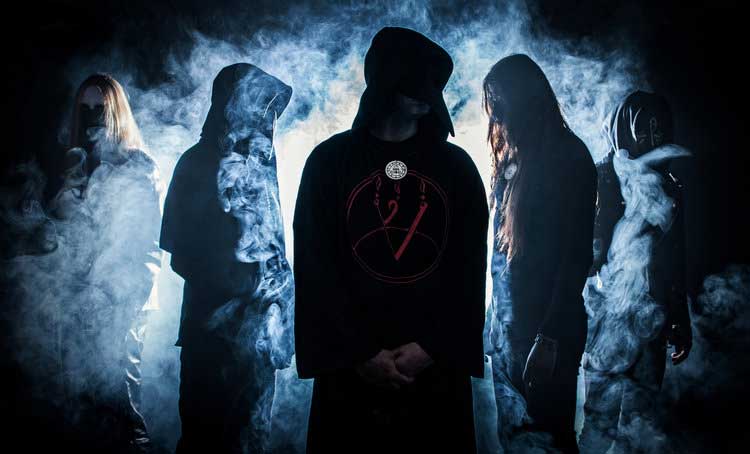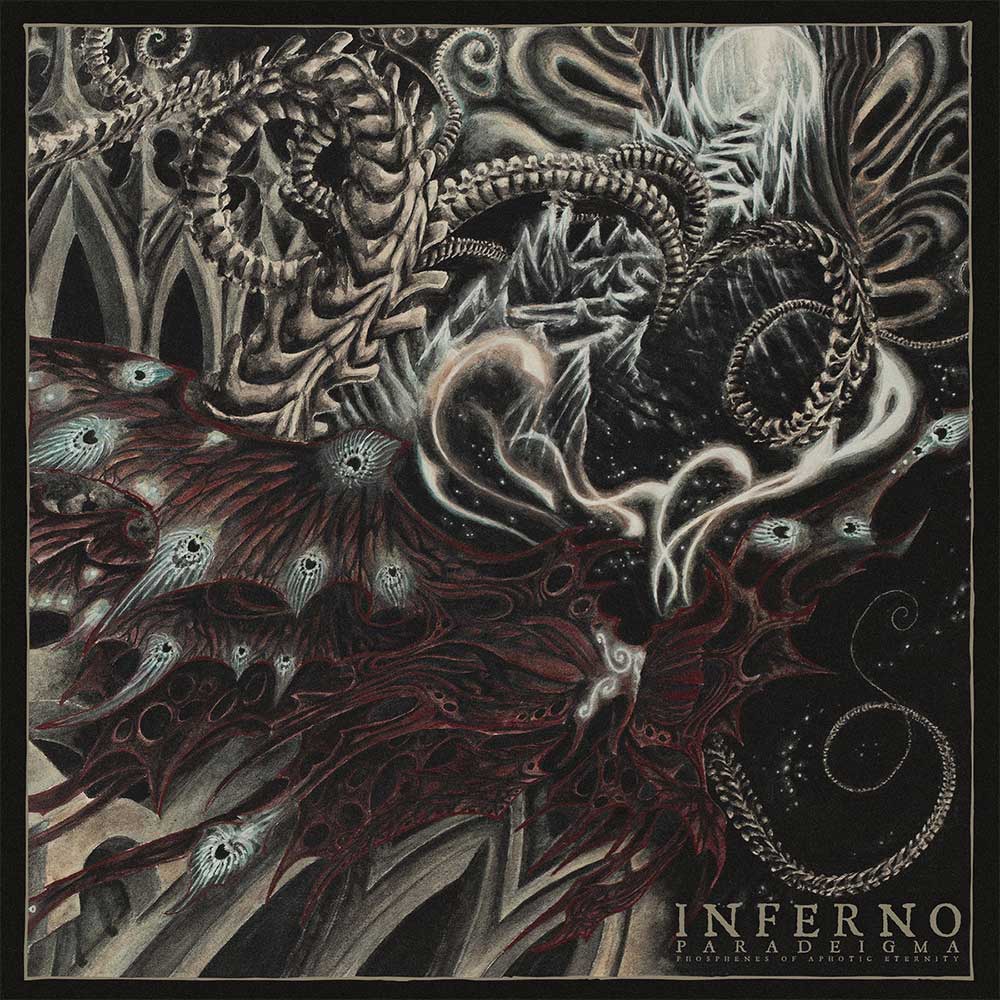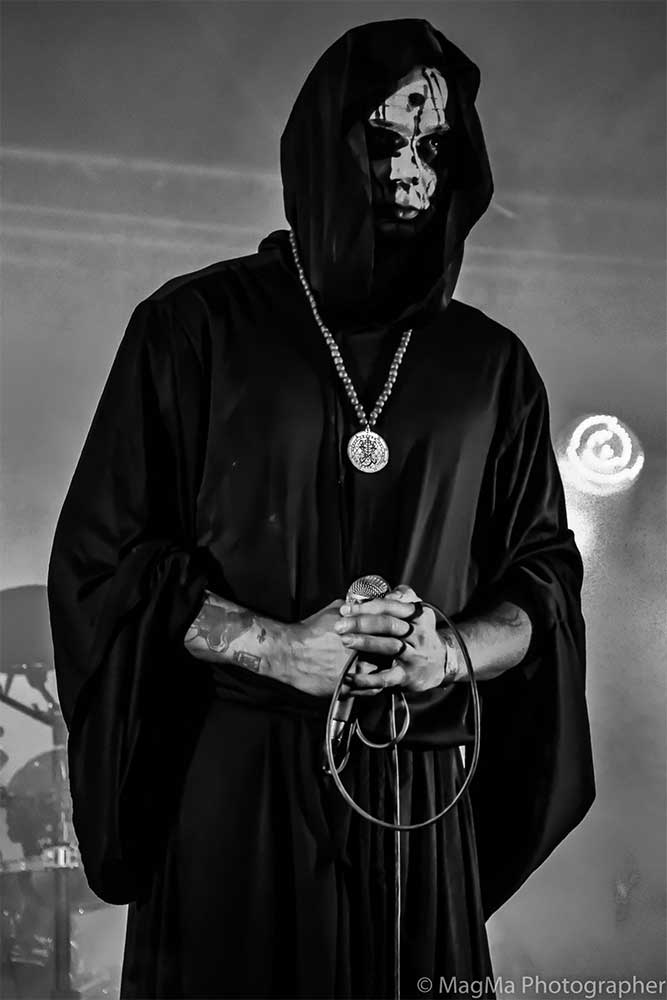Inferno
2021-11-03
by Niklas Göransson
The phosphenes of aphotic eternity glimpsed – a conversation about pushing past the confines of music and time with Czech black metal band Inferno.
– Let’s say that with the two previous albums – “Omniabsence Filled by His Greatness” and “Gnosis Kardias” – we managed to recreate and strengthen our identity as one fundamentally rooted in black metal, says shadow member Spící hrdlo Antikrista. However, we also let our creativity loose and allowed influences from beyond the confines of extreme metal to seep into our music. We will always have profound reverence for bands like MANIAC BUTCHER, the old Scandinavian guard, and the End All Life and NoEvDia acts, but at the same time there was a great affection for the radical and adventurous forms of heavy music from the 70s and 80s.
“Paradeigma (Phosphenes of Aphotic Eternity)”, the eighth studio album of INFERNO, was released by Debemur Morti Productions in May 2021.
– Most of the individual contributions were made separately, but we had a few opportunities to meet and discuss the work in detail. We also have reason to believe that there is a transpersonal connection between us. The deliberations I had with Ska-Gul (guitars) concerning the works-in-progress were unforgettable. We are not in regular contact, so sometimes we didn’t even know what the other was doing – but when we started discussing our visions there was a great sense of communion and unexpected overlap. Adramelech (vocals) influences every step within INFERNO, and he was given free rein to create and arrange the lyrics from my conceptual text. Some of these ideas were turned on top of their head, but the sense that emerged brought this work to another level while, in my opinion, working perfectly with the actual music.
The new album builds further upon the eccentric foundation laid out by “Gnosis Kardias (Of Transcension and Involution)”. Increased focus has been placed on the rather innovative use of guitar effects – chorus, echo, reverb, delay, and so on – which results in several layers of strange sounds one might otherwise assume came from a keyboard.
– This is owed to the evolution of Ska-Gul‘s use of basic guitar effects – he’s figured out almost everything by himself through the years. While being a highly skilled guitarist, he strives for the simpler but more intuitive translation of inner feelings and occasionally gives in to spontaneous experimentation. All songs have personal visions attached to them; there was a kind of synaesthesia going on where flows of emotion were associated with colours, and the guitar tones were meant to paint these.

I wonder how much of the increased sense of ambience and the less metal-sounding approach could be attributed to Ska-Gul composing the material on his own this time, as opposed to in a rehearsal place accompanied by human percussion.
– The chemistry with the drummers has been important primarily for the fundamental song-structures; furthermore, the fact that it was our former member Sarapis who encouraged Ska-Gul to start experimenting with guitar layering cannot be overlooked. Nevertheless, there is another important aspect to consider: our last two albums were recorded in two separate week-long sessions at Necromorbus Studios. The drums and basic guitarwork were recorded first, which required prior rehearsals. Bass, vocals, and additional guitar layers were tracked during the second visit a few months later. Ska-Gul had the “Omniabsence…” songs envisioned and demoed before entering the studio, but because of the timespan between sessions – as well as the fact that the basic guitars and drums were now properly recorded – he made new demos upon which the album’s layered arrangements exceeded their initial form.
“Gnosis Kardias” was also recorded on two separate occasions, but this time Ska-Gul tracked most of the additional guitar layers at home and then sent them over to Necromorbus for mixing and mastering courtesy of Tore Stjerna.
– The “Omniabsence…” demos were quite messy and left a lot of room for imagination, but with “Gnosis Kardias” we could orient ourselves somewhat in the various layers and details – but the atmosphere was quite different from the final product. Leading up to “Paradeigma”, Ska-Gul‘s recording skills had improved and allowed for more complex arrangements, which saved everyone a lot of time and nerves. Ska-Gul composed the soundscapes right away, without the foundation of distorted guitars and drums. Most of “Paradeigma” was composed and demoed like this, with continuous feedback from other core members. A friend of ours, Sheafraidh, provided technical advice, especially concerning the drum programming. Listening to the early demos was greatly visual and stimulating for our creativity, which we infused in the subsequent work. And once it became clear that the cooperation with the drummer we had from 2017 to 2020 was going nowhere, we invited Sheafraidh to record the drums at his studio and in full accordance with his vision.

After each member had recorded their contributions separately, all of it was sent to Stephen Lockhart at Iceland’s Studio Emissary. INFERNO’s part of the 2019 split with DEVATHORN came about the same way.
– We were satisfied with Stephen‘s work on our contribution to “Zos Vel Thagirion”, says Adramelech, but it became immediately clear that this was just the beginning; there is a lot more we can accomplish together. It should also be noted that “Tabernaculum” – an album by his band, REBIRTH OF NEFAST – was not only a frequent point of reference but also the primary reason why we trusted him with our art in the first place. Not that we wanted to copy that record’s production, but we were aiming for something similarly absorbing and powerful.
I was reading a previous INFERNO interview when I noticed a fleeting remark alleging that the album was initially meant to be entirely devoid of distorted guitars. I assumed it was some kind of translation error and so consulted Stephen – but he confirmed.
– It was around the time of the DEVATHORN split that we discussed whether we should move on from just layering the individual guitar lines over each other – filling the empty musical spaces with tones – and instead fully embrace the concept of ambient-like guitar soundscapes. Already when recording “Gnosis Kardias”, we opted for less distortion on the basic guitars. With “Paradeigma” the composition process was reversed and, at first, we did not want any distorted guitars.
Stephen told me that the first version of the mix indeed featured ambient guitars only. Seeing as how INFERNO went on to re-evaluate this approach, I’m assuming it didn’t quite come out like they were hoping.
– Frankly, we were pretty disenchanted with the very first version; it felt like the complete opposite of what we were trying to achieve. In our demo mixing attempt, we nailed everything to our great satisfaction; the only problem being that the general volume was pretty low, so the music lacked punch. We initially thought Stephen could just replicate our version of the mix but increase the volume of the instruments, balance them out, and make it all work somehow. But it turned out to be a bit more complex than that, especially with an album like “Paradeigma”. Stephen tried his best, but it soon became evident that the material needed distorted guitars. So, Ska-Gul recorded and sent them over for re-amping. First, we tried it out with “The Wailing Horizon”, and after realising the necessity for our record to have a proper impact, we decided to proceed with the rest.
After the interview, INFERNO were kind enough to provide me with both their demo and Stephen’s first version of the mix. I wish I’d heard this before listening to the finished album. Initially, without the guitars, there was a constant sense of anticipation for the song to start in earnest. However, once I got used to the somewhat hollow acoustics, it became clear that the effects and surrounding ambience had been meticulously crafted with the intention of fully carrying the music on their own. These qualities definitely shine through in manner which was not immediately apparent on the final version. The vocals really suit this approach as well. Overall, the slower parts sound very interesting, but a lot of power is lost when the speed picks up. Stephen also mentioned that even if it occasionally made the collaboration strenuous, the entire venture was built on a mutual respect for each other’s artistic stubbornness and general unwillingness to compromise.
– The mutual respect is definitely there, says Adramelech. We understand why we seemed stubborn, but more so than before we tried to reify our vision of the album as faithfully as possible. Each and every tone was considered important within our overarching framework, with all the individual details developing and supplementing each other. The music of “Paradeigma” is a carefully curated mosaic, where each part – no matter if its origin is involuntary or rational – serves a purpose. Compromise requires both sides to make concessions, possibly to the detriment of the desired result, but we are convinced that we found a ‘third way’ which took our perspectives and moulded them into something even stronger.
Honestly, if I’d just heard this record without knowing who it was, I’d likely be thinking ‘I bet this band does not perform live.’ Most decidedly not the case with INFERNO.
– I’m obviously biased, says Spící hrdlo Antikrista, but I have seen INFERNO on stage more than twenty times in the past years. So, I dare say that the material from “Gnosis Kardias” and “Omniabsence…” translates well to the live setting – provided the sound is alright. But my favourite memories of the live renditions are when the guys practised the set unplugged in various backstages and hotel rooms. The fundamental bare strength of the songs never fails to send shivers down my spine, despite having heard them hundreds of times before.
How much atmosphere is lost when the songs are re-arranged for two guitars and bass?
– The immersive psychedelic depth and some details are sacrificed, of course, but it is greatly compensated by the increased intensity. On stage, Adramelech‘s presence and voice come into focus, and the drummer obviously has a significant effect on the live performances. Interestingly, some guitar parts in “The Funeral of Existence” and “Gate-Eye of Fractal Spiral” underwent a significant change – to the point of being noticeably different from the album versions – but the main motivation was to keep the material fresh for both performers and attendees.
– Right now, says Adramelech, we are rehearsing “Paradeigma” in its entirety, plus a few other songs, as a four-piece – two guitars, drums, and vocals – alongside the additional samples, which makes the current live renditions more faithful. Of course, certain re-arrangements were necessary, but we are very satisfied with the way our new songs work, and especially feel, during rehearsals. Sheafraidh’s know-how as a sound-engineer definitely helps us here. But in case things go wrong and we must play without samples, people should still recognise our new songs and the vibe will be maintained.
– For the future, says Ska-Gul, we are open to enlisting additional live members – but following the last line-up changes we did not want to go through the process of trying out new people all over again. We felt it could jeopardise the great chemistry our band is currently experiencing. These live renditions will soon be put to the test at concerts in Poland, Ukraine, and the Czech Republic. Also, people from around the world will be able to witness “Paradeigma” at Iceland’s Ascension Festival in November. We are also negotiating some interesting tours for 2022, but who knows what will become reality.

Before this interview took place, I was told that the 2017 INFERNO feature I did with Adramelech ended up influencing the new album’s thematic content.
– When Adramelech mentioned Andrew Chumbley‘s Azoëtia in the first interview, says Spící hrdlo Antikrista, I knew I had to borrow this book from him. Its literary form – as well as the illustrations, I assume – had a visceral effect on me, so I tried to keep that feeling in heart and mind while putting together English translations of the lyrics. Thanks to the book, I also looked deeper into the concept of Azoth which, in turn, lured me down an alchemical rabbit-hole. But in the end, it served as a personal metaphor for the process of self-organisation connected to the universal evolution and personal individuation… as well as a useful reminder to limit the scope of conceptual studies.
So, the overarching theme for “Paradeigma” is some kind of fictional universe?
– Yes. Before we got started, it was decided that this album must take INFERNO’s sound even further. However, we felt it necessary to emphasise the genre’s sinister essence as we perceive it. One way to achieve this, we thought, was to create our own musical and conceptual world, in the same manner as genre-defining albums – old and modern, none of them requiring an introduction – but also BLUT AUS NORD‘s “MoRT” which remains a singular, inimitable work of black metal. According to some, it went overboard in its dreadful experimentation, yet records like this left us convinced that there is nothing like going too far as long as the essence is kept. And that’s what has made this genre such a fascinating art-form. Our vision of this world was initially very abstract, but we kept obsessively feeding it creativity over the course of several months. Our artistic goal was in constant consideration until we were able to give it definite form.
The ‘devilgod’ is a prominent character in the “Paradeigma” narrative. This entity was modelled after Abraxas, an archetype laid out by famed Swiss psychoanalyst Carl Jung in his The Red Book – a collection of writings from 1915 to 1930. Jung founded a school of psychotherapy called analytical psychology, one which has since proven highly relevant for a number of fields: philosophy, theology, archaeology, anthropology, and so on. Jung is also credited with defining important psychological concepts such as the collective unconscious, archetypal phenomena, and synchronicity.
– As Adramelech mentioned in the first conversation, the title “Gnosis Kardias” was found in Stephen Hoeller’s book The Gnostic Jung and the Seven Sermons to the Dead. From there it was only a small step towards The Red Book and a deeper dive into Jung’s oeuvre. The Seven Sermons to the Dead are part of a large chapter entitled Scrutinies, which concludes The Red Book, and that’s where you can find a description of this entity. The whole work is a fascinating read for plenty of reasons, but the sermons pertaining to Abraxas were especially spine-chilling. More importantly, The Red Book provided an incentive to experiment with ourselves and use the process in the creative work, something we discussed at length while touring Europe with MAYHEM. There are several other strong memories concerning The Red Book – sometimes connected to synchronicities – which had a direct influence on “Paradeigma”.
Can you give an example?
– During the process of concept creation, I was ruminating what kind of role time plays in our imagined universe. I knew Lee Smolin‘s Time Reborn would provide inspiration, but it was not until I got stuck while writing the initial conceptual text that I browsed through the final summarising chapter of Time Reborn along with my notes and then, on impulse, opened The Red Book near its end. There I immediately saw an underlined footnote that in English reads ‘Abraxas is a time god’, but which in the Czech translation actually allows for an interpretation that makes Abraxas subordinate to time. The sudden realisation sent shivers down my spine, and I knew exactly what to do. To establish time as the lowest common denominator for all the rhythms of creation and an abstract, constantly flowing layer upon which both universes and demiurges manifest, perish and ‘evolve’.
The premise of the album is that an Abraxas-like entity, which both creates and destroys, dreams the entire universe into existence.
– Reality as we perceive it manifests through dualities, and the inhuman Abraxas is a metaphor of that – being the fundamental pair of opposites from which the self and, later, the consciousness emerge. In the world we live in, consciousness manifests in the upper layers of the universal existence. But in our concept, it is the fundamental one manifested upon the flow of time. Our idea of time does not strictly adhere to anything presented by Newtonian physics, Mircea Eliade, or Time Reborn – however, Smolin provided a thought that even the fundamental laws of physics could have evolved over time and might continue doing so in the future. Which brings us to the idea: what if universes evolve as well?



